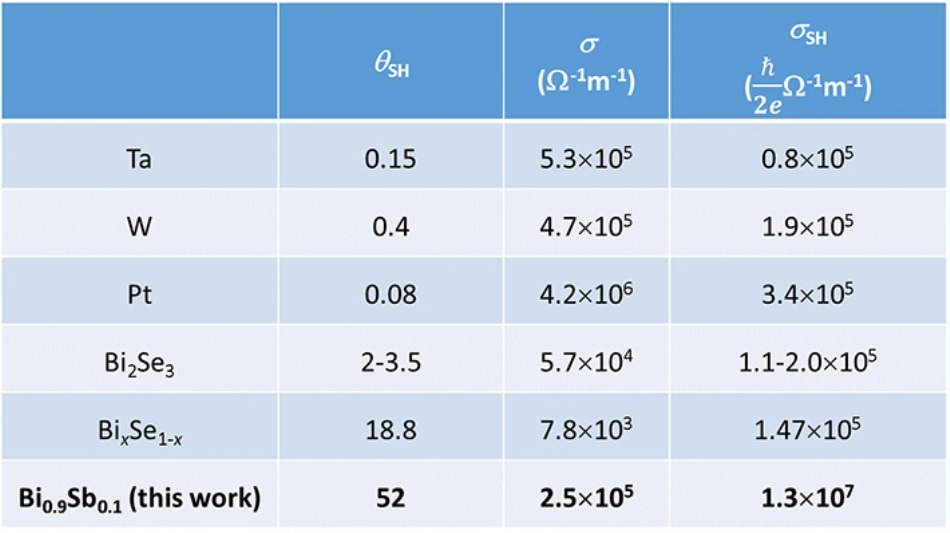Aug 3 2018
The world’s best-performing pure spin current source1 made of bismuth–antimony (BiSb) alloys has been developed by researchers and has been reported as the ideal candidate for the first industrial application of topological insulators.2
 Performance comparison between several heavy metals and topological insulators at room temperature. thetaSH: spin Hall angle, sigma: conductivity, sigmaSH: spin Hall conductivity. The figures in the bottom row are those achieved in the present study. Remarkably, the spin Hall conductivity, shown in the right-hand column, is two orders of magnitude greater than the previous record. (Image credit: Pham Nam Hai)
Performance comparison between several heavy metals and topological insulators at room temperature. thetaSH: spin Hall angle, sigma: conductivity, sigmaSH: spin Hall conductivity. The figures in the bottom row are those achieved in the present study. Remarkably, the spin Hall conductivity, shown in the right-hand column, is two orders of magnitude greater than the previous record. (Image credit: Pham Nam Hai)
The success symbolizes a huge leap forward in the development of spin-orbit torque magnetoresistive random-access memory (SOT-MRAM)3 devices, which could prospectively replace prevalent memory technologies.
A research group headed by Pham Nam Hai from the Department of Electrical and Electronic Engineering, Tokyo Institute of Technology (Tokyo Tech), has created thin films of BiSb for a topological insulator that realizes a colossal spin Hall effect4 and high electrical conductivity at the same time.
Their research, reported in the Nature Materials journal, could speed up the development of ultra-low power, high-density, and ultra-fast non-volatile memories for Internet of Things (IoT) and other applications that are currently sought after increasingly for industrial and home use.
The BiSb thin films realize a conductivity of 2.5 × 105, colossal spin Hall angle of approximately 52, and spin Hall conductivity of 1.3 × 107 at room temperature. Specifically, the spin Hall conductivity is two orders of magnitude greater than that of bismuth selenide (Bi2Se3), reported in 2014 in Nature.
Making SOT-MRAM a Viable Choice
To date, the hunt for suitable spin Hall materials for futuristic SOT-MRAM devices has been hampered by a challenge: First, although heavy metals such as tantalum, platinum, and tungsten have high electrical conductivity, they have a small spin Hall effect. Second, topological insulators analyzed until now have a large spin Hall effect yet low electrical conductivity.
The BiSb thin films fulfill both demands at ambient temperature. This increases the real probability of BiSb-based SOT-MRAM outperforming the prevalent spin-transfer torque (STT) MRAM technology.
As SOT-MRAM can be switched one order of magnitude faster than STT-MRAM, the switching energy can be reduced by at least two orders of magnitude. Also, the writing speed could be increased 20 times and the bit density increased by a factor of ten.
Pham Nam Hai, Department of Electrical and Electronic Engineering
Recently, the practicality of such energy-efficient SOT-MRAMs has been experimentally demonstrated, though using heavy metals, by IMECouter, the international R&D and innovation hub headquartered in Leuven, Belgium.
Upon successful optimization, BiSb-based SOT-MRAM could be a dramatic enhancement over its heavy metal-based equivalents and even turn out to be competitive with dynamic random access memory (DRAM), the existing dominant technology.
An Attractive, Overlooked Material
The research community has tended to overlook BiSb due to its small band gap5 and complex surface states. However, Pham stated that “From an electrical engineering perspective, BiSb is very attractive due to its high carrier mobility, which makes it easier to drive a current within the material.”
“We knew that BiSb has many topological surface states, meaning we could expect a much stronger spin Hall effect. That’s why we started studying this material about two years ago.”
A high-precision technique known as molecular beam epitaxy (MBE) was employed for growing the thin films. The scientists found out a specific surface orientation called BiSb(012), which is considered to be an important factor causing the large spin Hall effect. Pham indicates that another key factor is the number of Dirac cones6 on the BiSb(012) surface, which is currently being analyzed by his team.
Challenges Ahead
At present, Pham is collaborating with industry to investigate and optimize BiSb-based SOT-MRAM.
The first step is to demonstrate manufacturability. We aim to show it’s still possible to achieve a strong spin Hall effect, even when BiSb thin films are fabricated using industry-friendly technologies such as the sputtering method.
It’s been over ten years since the emergence of topological insulators, but it was not clear whether those materials could be used in realistic devices at room temperature. Our research brings topological insulators to a new level, where they hold great promise for ultra-low power SOT-MRAM.
Pham Nam Hai, Department of Electrical and Electronic Engineering
Technical Terms
1Pure spin current - A phenomenon whereby spin angular momentum, but not charge, is transported.
2Topological insulators - Materials with highly electrically conductive surfaces, but which act as insulators on the inside. Such materials are of great interest in the quest to develop high-performing electronic devices that generate less heat.
3SOT-MRAM - Spin-orbit torque (SOT) switching using the spin Hall effect is increasingly viewed as a successor to conventional spin-transfer torque (STT) switching for magnetoresistive random-access memory (MRAM) technologies.
4Spin Hall effect - A Hall effect for spins originating from the coupling of charge and spin. Pure spin currents can be generated via the spin Hall effect.
5Band gap - An energy range in an insulator or semiconductor in which no electron states can exist.
6Dirac cones - Unique electronic structures that occur in topological insulators that represent linear energy dispersion.